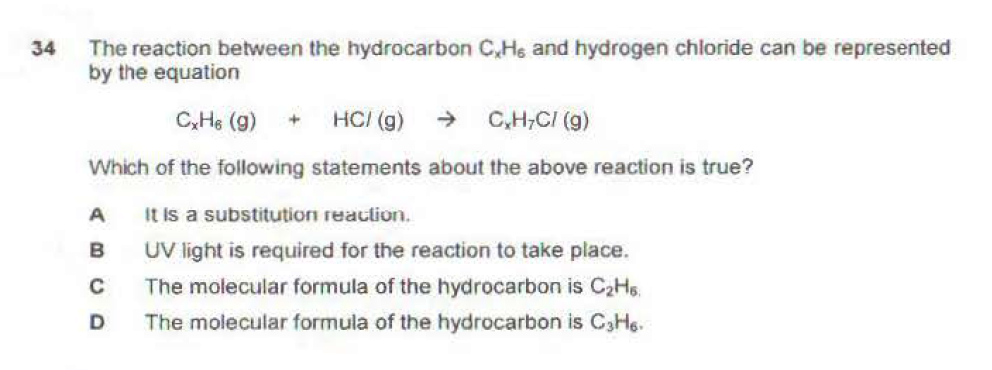Hi UltimaOnline,
I would like to seek your opinion/concurrence for some of the
questions where my answers diverged from the answers in the answer
scheme :) :

Remarks: The answer is B but I got A. Given the number of moles of
ammonium nitrate used is 0.1, the number of moles of ammonia
produced should be 0.1 too, so I think the volume produced should
be 2.4dm³. Btw, what is the role of the aluminium powder in the
reaction?

Remarks: The answer is A. What should I be looking out
for?

Remarks: The answer is A but I think the answer is B. As greater
number of moles of lead (II) nitrate was present in Experiment II ,
there should be more lead (II) iodide formed in experiment 2, thus
the total mass of lead (II) iodide is smaller in I.

Remarks:The answer is B but I think the answer is D. I would think
this is an electrophilic addition reaction of an alkene rather than
an FRS reaction.
Hi Gohby,
Your own answer for the last question about electrophilic addition
of hydrogen halide across an alkene double bond is correct. Don't
put too much trust in Singapore secondary schools' teachers'
answers, or Singapore assessment practice books' answers, or
Singapore TYS publishers' answers.
Q1. Al is oxidized to Al3+, and NO3- (OS of N = +5) is reduced to
NH4+ (OS of N = -3). Thus a total of 0.1 + 0.1 = 0.2 mol of NH4+ is
deprotonated by the OH- to generate 0.2 mol of NH3, which works out
to be 4.8 dm3.
Q2. You need to use insoluble bases (ie. hydroxides and
carbonates), as soluble alkalis are corrosive and will damage your
mouth, throat and esophagus before it can reach your stomach to
reduce acidity. (Medical note : aluminium is toxic and causes brain
damage, thus shouldn't be used in drugs or additives, yet its use
continues to be widespread, contributing to Alzheimer's disease and
other related dementia medical conditions)
Q3. Either A or B could be correct, depending on the molarity of
KI. If the molarity of KI is sufficiently low, it's *possible* for
the mass of ppt generated in experiment 2 to be *less* than in
experiment 1 (despite the moles of Pb2+ in experiment 2 being more
than in experiment 1), because the total volume of solution in
experiment 2 is greater. The secondary school teacher who set this
question was being a smart-ass and must have been proudly confident
of having set the trickiest O level Chemistry prelim paper question
among all the secondary schools for that year (there's always an
informal competition to set the toughest prelim papers, just look
at the top JCs' prelim papers, most JC teachers themselves wouldn't
be able to get an A grade if they sat for the top JCs' prelim
papers within the allocated time). Unfortunately, he/she didn't
realize that since the molarity of KI wasn't specified, if the
molarity was sufficiently high, then even with a larger volume of
solution, 99.9% of the moles PbI2(s) could be precipitated out in
both experiments, then *your* answer would be correct. So this
question has insufficient data to conclusively rule out either A or
B.